Authentic museum-houses in Tryavna
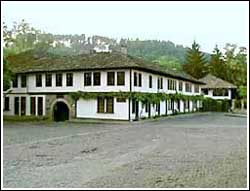
The Tryavna Shkolo, or school, set up between 1836 and 1839 ranked among the
first secular schools in Bulgaria. In the course of eight years, some breaks
notwithstanding, Petko R. Slaveikov, an influential writer, settled down to
a life of a teacher here.
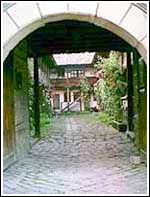 In the school itself was set up a book depository,
one of the earliest known in Bulgaria (1847), and the local community centre
named "Troudolyubie" (1871) which translates "diligence".
In the school itself was set up a book depository,
one of the earliest known in Bulgaria (1847), and the local community centre
named "Troudolyubie" (1871) which translates "diligence".

The refurbished building of the shkolo holds several
interesting museum collections:
- Documents and authentic objects from the Enlightenment period in Bulgaria
until the Liberation.
- A display of time-pieces from ancient times to the
beginning of the 20th century, collected and restored by Georgi Vezirov.
- An art collection permanently on show
which is donated by the brothers Dimitur and Nikoka Kazakovi. 600
paintings and wood-carved pieces defend the inimitable artwork of the
brothers, and in fact, it is the largest one and the only collection of their
works shown in this country.
Temporary exhibitions are displayed at the school as well.
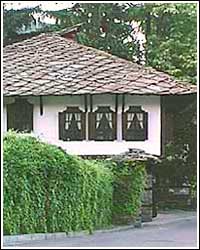
The Raykov museum-house is a typical example of late Renaissance
architecture in Tryavna. Raised in 1846 by master-builder Dimitur Sergyev,
the spacious, two-storeyed house overlooking the street is a symbol of the
spirit and self-confidence of the Renaissance-period man. Originally the home
of the scientist Pencho N. Raikov, the "father of Bulgarian chemistry",
exhibits the domestic life of late nineteenth century.
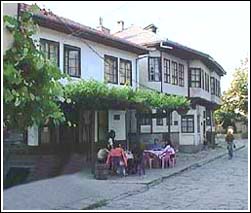
Petko R. Slaveikov street (in uptown neighbourhood) is possibly the best
preserved Renaissance street in Bulgaria.
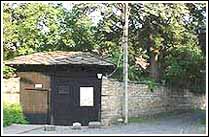
The matchless Daskalov's house with the ceilings of never-setting suns is
located there. Built between 1804 and 1808
by master-builder Dimitur Oshanetsa and his assistant Ivan Bochoukovetsa,
the house typifies an early Renaissance building in Tryavna.
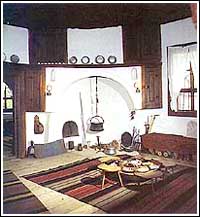 In 1808 both men made a bet and contended for the mastery of the ceilings which
took them 6 months to carve. Even today the sun motifs remain an unrivalled
eminence of wood-carving craftsmanship. The house holds the one and the only in
this country museum of wood-carving, as well as wood-carvings and wood
sculptures of Bulgarian khans and tsars, bas-reliefs of outstanding figures
from the Renaissance period - all these being the handiwork of Gencho
Marangoza, a prominent wood-carver.
In 1808 both men made a bet and contended for the mastery of the ceilings which
took them 6 months to carve. Even today the sun motifs remain an unrivalled
eminence of wood-carving craftsmanship. The house holds the one and the only in
this country museum of wood-carving, as well as wood-carvings and wood
sculptures of Bulgarian khans and tsars, bas-reliefs of outstanding figures
from the Renaissance period - all these being the handiwork of Gencho
Marangoza, a prominent wood-carver.
Click here to see a larger picture

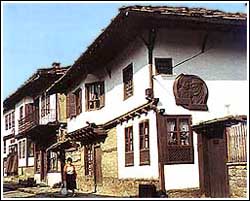 The Slaveikov's museum-house can be found in the same street. Some short
breaks notwithstanding, Petko R. Slaveikov, a distinguished Bulgarian poet
and public figure of the Renaissance period, lived here between 1835
and 1876. The house was the birthplace of his nine children among whom the
Bulgarian classic Pencho Slaveikov stood out. Documents and domestic
life exhibits are on display in the museum.
The Slaveikov's museum-house can be found in the same street. Some short
breaks notwithstanding, Petko R. Slaveikov, a distinguished Bulgarian poet
and public figure of the Renaissance period, lived here between 1835
and 1876. The house was the birthplace of his nine children among whom the
Bulgarian classic Pencho Slaveikov stood out. Documents and domestic
life exhibits are on display in the museum.
 Another masterpiece of the Renaissance architecture is the Kalinchev's
house, erected in 1830 by master builder Dimitur Sergyuv. A collection
of paintings donated to the town by Totyu Gubenski is housed in it. The
collection consists of works by 80 Bulgarian artists from the turn of the
last century to the present day. The latest contribution is a donation
made by Donka and Georgi Gubenski. Two more exhibitions donated by local
artists are displayed in two separate buildings - Ivan Kolev's collection
of paintings and sculptures which features the varied artistic talents of
the sculptor, and Ivan Popdimitrov's drawings, sketches and portraits from
the beginning of the century.
Another masterpiece of the Renaissance architecture is the Kalinchev's
house, erected in 1830 by master builder Dimitur Sergyuv. A collection
of paintings donated to the town by Totyu Gubenski is housed in it. The
collection consists of works by 80 Bulgarian artists from the turn of the
last century to the present day. The latest contribution is a donation
made by Donka and Georgi Gubenski. Two more exhibitions donated by local
artists are displayed in two separate buildings - Ivan Kolev's collection
of paintings and sculptures which features the varied artistic talents of
the sculptor, and Ivan Popdimitrov's drawings, sketches and portraits from
the beginning of the century.
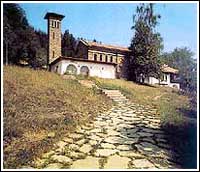 On the picturesque outskirts of the town, close to the Children's
Sanatorium named after Tsar Boris III, is the Museum of Icon-Painting and
Wood-Carving. It is housed in the Tsar's chapel raised between 1943 and
1944, and donated to the town by Tsaritsa Joanna. The museum treasures
the one and the only representative collection of Tryavna icons from the 17th
to the turn of the 19th century. Over 160 original icons represent the
creative output of the six renowned families of icon-painters. The exhibits
on display rank among the most fascinating artistic samples of the school.
Along with the icons, authentic icon-painting tools, designs, guidelines,
etc., are on display.
On the picturesque outskirts of the town, close to the Children's
Sanatorium named after Tsar Boris III, is the Museum of Icon-Painting and
Wood-Carving. It is housed in the Tsar's chapel raised between 1943 and
1944, and donated to the town by Tsaritsa Joanna. The museum treasures
the one and the only representative collection of Tryavna icons from the 17th
to the turn of the 19th century. Over 160 original icons represent the
creative output of the six renowned families of icon-painters. The exhibits
on display rank among the most fascinating artistic samples of the school.
Along with the icons, authentic icon-painting tools, designs, guidelines,
etc., are on display.
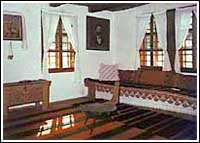 Part of the Renaissance set-piece is Angel Kunchev's
birthplace and museum-house built about 1805. Documents and domestic life
exhibits follow the life and revolutionary work of Angel Kunchev, the
struggle of the townspeople to break from the shackles of the Turkish Yoke and
the participation of the town in the Russian-Turkish War for Liberation
(1877-1878).
Part of the Renaissance set-piece is Angel Kunchev's
birthplace and museum-house built about 1805. Documents and domestic life
exhibits follow the life and revolutionary work of Angel Kunchev, the
struggle of the townspeople to break from the shackles of the Turkish Yoke and
the participation of the town in the Russian-Turkish War for Liberation
(1877-1878).
In the vicinity is Priest Angel's House - the oldest architectural monument
in Tryavna, dating back to the 13th century. On one of his numerous visits
to Tryavna, the Apostle Vasil Levski stayed in it.
On the way to the railway station, along Angel Kunchev's Street, rises
St. Georgi Church. Its construction was designed and supervised by master
builder Dimitur Sergyuv between 1848 and 1852. The iconostasis was the
handiwork of Nikola Dragostinov, Dimitur Doikovcheto and other skilled
wood-carvers; the icons were painted by Dosyu Koyuv and Tsonyu Simeonov.
Back to main page

 In the school itself was set up a book depository,
one of the earliest known in Bulgaria (1847), and the local community centre
named "Troudolyubie" (1871) which translates "diligence".
In the school itself was set up a book depository,
one of the earliest known in Bulgaria (1847), and the local community centre
named "Troudolyubie" (1871) which translates "diligence".



 In 1808 both men made a bet and contended for the mastery of the ceilings which
took them 6 months to carve. Even today the sun motifs remain an unrivalled
eminence of wood-carving craftsmanship. The house holds the one and the only in
this country museum of wood-carving, as well as wood-carvings and wood
sculptures of Bulgarian khans and tsars, bas-reliefs of outstanding figures
from the Renaissance period - all these being the handiwork of Gencho
Marangoza, a prominent wood-carver.
In 1808 both men made a bet and contended for the mastery of the ceilings which
took them 6 months to carve. Even today the sun motifs remain an unrivalled
eminence of wood-carving craftsmanship. The house holds the one and the only in
this country museum of wood-carving, as well as wood-carvings and wood
sculptures of Bulgarian khans and tsars, bas-reliefs of outstanding figures
from the Renaissance period - all these being the handiwork of Gencho
Marangoza, a prominent wood-carver.

 The Slaveikov's museum-house can be found in the same street. Some short
breaks notwithstanding, Petko R. Slaveikov, a distinguished Bulgarian poet
and public figure of the Renaissance period, lived here between 1835
and 1876. The house was the birthplace of his nine children among whom the
Bulgarian classic Pencho Slaveikov stood out. Documents and domestic
life exhibits are on display in the museum.
The Slaveikov's museum-house can be found in the same street. Some short
breaks notwithstanding, Petko R. Slaveikov, a distinguished Bulgarian poet
and public figure of the Renaissance period, lived here between 1835
and 1876. The house was the birthplace of his nine children among whom the
Bulgarian classic Pencho Slaveikov stood out. Documents and domestic
life exhibits are on display in the museum.
 Another masterpiece of the Renaissance architecture is the Kalinchev's
house, erected in 1830 by master builder Dimitur Sergyuv. A collection
of paintings donated to the town by Totyu Gubenski is housed in it. The
collection consists of works by 80 Bulgarian artists from the turn of the
last century to the present day. The latest contribution is a donation
made by Donka and Georgi Gubenski. Two more exhibitions donated by local
artists are displayed in two separate buildings - Ivan Kolev's collection
of paintings and sculptures which features the varied artistic talents of
the sculptor, and Ivan Popdimitrov's drawings, sketches and portraits from
the beginning of the century.
Another masterpiece of the Renaissance architecture is the Kalinchev's
house, erected in 1830 by master builder Dimitur Sergyuv. A collection
of paintings donated to the town by Totyu Gubenski is housed in it. The
collection consists of works by 80 Bulgarian artists from the turn of the
last century to the present day. The latest contribution is a donation
made by Donka and Georgi Gubenski. Two more exhibitions donated by local
artists are displayed in two separate buildings - Ivan Kolev's collection
of paintings and sculptures which features the varied artistic talents of
the sculptor, and Ivan Popdimitrov's drawings, sketches and portraits from
the beginning of the century.
 Part of the Renaissance set-piece is Angel Kunchev's
birthplace and museum-house built about 1805. Documents and domestic life
exhibits follow the life and revolutionary work of Angel Kunchev, the
struggle of the townspeople to break from the shackles of the Turkish Yoke and
the participation of the town in the Russian-Turkish War for Liberation
(1877-1878).
Part of the Renaissance set-piece is Angel Kunchev's
birthplace and museum-house built about 1805. Documents and domestic life
exhibits follow the life and revolutionary work of Angel Kunchev, the
struggle of the townspeople to break from the shackles of the Turkish Yoke and
the participation of the town in the Russian-Turkish War for Liberation
(1877-1878).